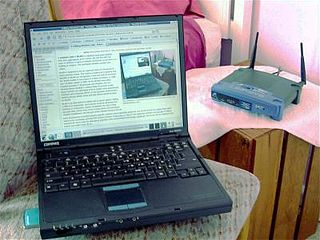
Digital Enhanced Cordless Telecommunications , usually known by the acronym DECT, is a standard primarily used for creating cordless telephone systems. It originated in Europe, where it is the universal standard, replacing earlier cordless phone standards, such as 900 MHz CT1 and CT2.

A wireless LAN (WLAN) is a wireless computer network that links two or more devices using wireless communication to form a local area network (LAN) within a limited area such as a home, school, computer laboratory, campus, or office building. This gives users the ability to move around within the area and remain connected to the network. Through a gateway, a WLAN can also provide a connection to the wider Internet.

A wireless network is a computer network that uses wireless data connections between network nodes.
Voice over Internet Protocol (VoIP), also called IP telephony, is a method and group of technologies for the delivery of voice communications and multimedia sessions over Internet Protocol (IP) networks, such as the Internet. The terms Internet telephony, broadband telephony, and broadband phone service specifically refer to the provisioning of communications services over the public Internet, rather than via the public switched telephone network (PSTN), also known as plain old telephone service (POTS).
Enhanced 911, E-911 or E911 is a system used in North America to automatically provide the caller's location to 911 dispatchers. 911 is the universal emergency telephone number in the region. In the European Union, a similar system exists known as E112 and known as eCall when called by a vehicle.

A cordless telephone or portable telephone is a telephone in which the handset is portable and communicates with the body of the phone by radio, instead of being attached by a cord. The base station is connected to the telephone network through a telephone line as a corded telephone is, and also serves as a charger to charge the handset's batteries. The range is limited, usually to the same building or some short distance from the base station.

Voice over wireless LAN is the use of a wireless broadband network according to the IEEE 802.11 standards for the purpose of vocal conversation. In essence, it is voice over IP (VoIP) over a Wi-Fi network. In most cases, the Wi-Fi network and voice components supporting the voice system are privately owned.

An intercom, talkback or doorphone is a stand-alone voice communications system for use within a building or small collection of buildings, functioning independently of the public telephone network. Intercoms are generally mounted permanently in buildings and vehicles. Intercoms can incorporate connections to public address loudspeaker systems, walkie talkies, telephones, and to other intercom systems. Some intercom systems incorporate control of devices such as signal lights and door latches.

A VoIP phone or IP phone uses voice over IP technologies for placing and transmitting telephone calls over an IP network, such as the Internet, instead of the traditional public switched telephone network (PSTN).
Vertical handover or vertical handoff refers to a network node changing the type of connectivity it uses to access a supporting infrastructure, usually to support node mobility. For example, a suitably equipped laptop might be able to use both a high speed wireless LAN and a cellular technology for Internet access. Wireless LAN connections generally provide higher speeds, while cellular technologies generally provide more ubiquitous coverage. Thus the laptop user might want to use a wireless LAN connection whenever one is available, and to 'fall over' to a cellular connection when the wireless LAN is unavailable. Vertical handovers refer to the automatic fallover from one technology to another in order to maintain communication. This is different from a 'horizontal handover' between different wireless access points that use the same technology in that a vertical handover involves changing the data link layer technology used to access the network.
Generic Access Network (GAN) is a protocol that extends mobile voice, data and multimedia applications over IP networks. Unlicensed Mobile Access (UMA) is the commercial name used by mobile carriers for external IP access into their core networks. The latest generation system is named Wi-Fi Calling or VoWiFi by a number of handset manufacturers, including Apple and Samsung, a move that is being mirrored by carriers like T-Mobile US and Vodafone. The service is dependent on IMS, IPsec and ePDG.
Mobile VoIP or simply mVoIP is an extension of mobility to a Voice over IP network. Two types of communication are generally supported: cordless/DECT/PCS protocols for short range or campus communications where all base stations are linked into the same LAN, and wider area communications using 3G/4G protocols.

Fritz!Box, stylised as FRITZ!Box, is a series of residential gateway devices produced by the German company AVM GmbH. In 2010 it was estimated the series had a market share of 68% of the digital subscriber line (DSL) consumer equipment in Germany.

In telecommunications, a femtocell is a small, low-power cellular base station, typically designed for use in a home or small business. A broader term which is more widespread in the industry is small cell, with femtocell as a subset. It is also called femto AccessPoint (AP). It connects to the service provider's network via broadband ; current designs typically support four to eight simultaneously active mobile phones in a residential setting depending on version number and femtocell hardware, and eight to sixteen mobile phones in enterprise settings. A femtocell allows service providers to extend service coverage indoors or at the cell edge, especially where access would otherwise be limited or unavailable. Although much attention is focused on WCDMA, the concept is applicable to all standards, including GSM, CDMA2000, TD-SCDMA, WiMAX and LTE solutions.
A wide variety of different wireless data technologies exist, some in direct competition with one another, others designed for specific applications. Wireless technologies can be evaluated by a variety of different metrics of which some are described in this entry.
Dual mode mobiles refer to mobile phones that are compatible with more than one form of data transmission or network.

A headset combines a headphone with a microphone. Headsets are made with either a single-earpiece (mono) or a double-earpiece. Headsets provide the equivalent functionality of a telephone handset but with handsfree operation. They have many uses including in call centers and other telephone-intensive jobs and for anybody wishing to have both hands free during a telephone conversation.
Fixed–mobile convergence (FMC) is a change in telecommunications that removes differences between fixed and mobile networks.
Gigaset AG, formerly known as Siemens Home and Office Communication Devices is a multinational corporation based in Munich, Germany. The company is most active in the area of communications technology. Gigaset manufactures DECT telephones. In 2017, it had 930 employees, revenue of 293 million Euro and sales activities in approximately 70 countries.
Private GSM solutions, appeared after the deregulation of the DECT guardband in some countries, allow users and businesses to reduce their costs without impacting in their performance and offering a number of added value services. All of this thanks to the ability to create private mobile GSM networks, enabling mobile phone users to access the same services and features as users of a PBX extension.









